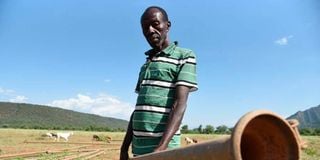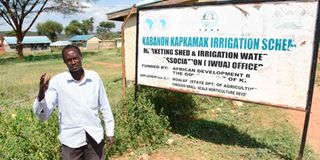Premium
Irrigation schemes lie in ruins as bandits wreak havoc in the fertilie Kerio Valley

William Rotich, a farmer at Kamsiwet Irrigation Scheme in Kerio Valley, Elgeyo Marakwet County on June 29, 2022.
What you need to know:
- There have been perennial skirmishes, and projects meant to offer livelihood alternatives for the locals estimated at over Sh1 billion are rusting away after they were abandoned as bandits tore the region apart.
- Most of the irrigation schemes produced maize, sorghum, millet, green grams, watermelons and vegetables, significantly alleviating the area’s food insecurity and generating income for the locals through the sale of surplus yields.
- Hunger pangs and poverty now parallel nostalgic memories of when the fields brought forth plenty of food and a steady source of income to thousands of residents.
Along the picturesque Kerio Valley lies a desolate land. Thousands upon thousands of acres are untilled.
And as far as the eye can see are shrubs, anthills, thorny trees and overgrown grass in its wildest forms.
This green and wild vegetation are not what ought to have been here. This was a farming paradise. The evidence of it is the rusting farm machinery.
Snakes and rodents that had been pushed further away have reclaimed their former territory; the cattle, goats and sheep that would graze as if on a vintage painting of a countryside scene are missing.
They have since been carted away by scary killers.
It is a forlorn place that perhaps looks like the rough times of early man. Hard times indeed for the residents.
It had not always been this way. There were better, more prosperous times when the people could smile, an epoch when hunger was unknown and work paid.
There are the sad stragglers of that era who reminisce in nostalgia about it. Desperation and fear of the present and the future have now taken root.
The past has boiled itself over, and these people are the steam that must escape if they have an option.
A long time ago, on this same land, at this time of the year, farmers in Arror would be harvesting crops from the various irrigation schemes in the region.
Abandoned schemes
They don’t do that anymore. There have been perennial skirmishes, and projects meant to offer livelihood alternatives for the locals estimated at over Sh1 billion are rusting away after they were abandoned as bandits tore the region apart.
Most of the irrigation schemes produced maize, sorghum, millet, green grams, watermelons and vegetables, significantly alleviating the area’s food insecurity and generating income for the locals through the sale of surplus yields.

Patrick Komen, a farmer at Kabanon Kapkamak Irrigation Scheme in Kerio Valley, Elgeyo Marakwet County on June 29, 2022.
Hunger pangs and poverty now parallel nostalgic memories of when the fields brought forth plenty of food and a steady source of income to thousands of residents.
Maureen Kipchumba, 38, one of the residents, says insecurity has taken them back.
“No farming has taken place in Kerio Valley for several years. People abandoned the farms because they were turned into battlefields. Several people were killed in the fields,” offers Kipchumba.
Robert Bargonga, 40, another farmer, says the region has already felt a food crisis due to abandoned farms. “A 2kg tin of maize commonly referred to as gorogoro retails at Sh250 instead of Sh80. Families cannot make ends meet because the schemes offered them an economic lifeline,” he notes.
The Nation visited the 600-acre Chepkum Irrigation Scheme, founded by Kerio Valley Development Authority (KVDA).
Although the region is relatively calm due to ongoing security operations, the field lies abandoned, with overgrown shrubs covering it.
Save for a few herders who are seen sheltering from the sweltering heat under acacia trees and a handful of goats grazing, the field is bleak and empty, and one would be forgiven to think it is a bush.
Evans Kosgei, 47, recalls how several people herding their animals were killed by bandits on January 4.
Seed bulking
“Nobody dared to come to this field. More than 1,000 residents were engaged in contractual farming doing seed bulking for various companies, raking in millions of shillings annually,” he says.
KVDA managing director Sammy Naporos says Chepkum farmers earned up to Sh20 million annually because of maize seed bulking.
“The farmers would harvest over 240 tonnes of maize seeds, earning them millions of shillings. Besides maize farming, the scheme also offered them an avenue to grow other crops both for local consumption and commercial,” says Naporos.

Timothy Kiplagat, a farmer at Kabanon Kapkamak Irrigation Scheme in Kerio Valley, Elgeyo Marakwet County on June 29, 2022. A big section of the scheme has been abandoned due to banditry in Kerio Valley, which has adversely affected the economy of the region.
A few kilometres away, the situation is no different at the 100-acre Kamsiwet Irrigation Scheme, also funded by KVDA.
Hundreds of anthills dot the once-lush millet fields. William Rotich, 52, one of the farmers at the project, says he had a one-and-a-half-acre millet and maize farm.
“I was engaged in seed-bulking. Two years ago, insecurity forced us to abandon the farms after bandits hiding in the nearby hills would shoot at anyone who entered the farm,” Rotich narrates.
“This has made us poor and ravaged by hunger, and we are calling on the government to offer us relief food because of ongoing hunger.”
Rotich says the scheme would offer them millions annually. But this is now a memory, and they rely on a few livestock that remained after bandits drove away others.
“The Chepkum and Kamsiwet farms that benefitted over 850 families remain inaccessible. The bandits also vandalised and carted away the fencing equipment. The farms no longer serve their intended purpose; they have been turned into a battlefield,” offers Naporos.
Starving locals
Besides the two irrigation schemes, the Sh300 million African Development Bank (AfDB) funded Kabonon/Kapkamak Irrigation Scheme, is largely unploughed.
“No one dares to go into the scheme to till the farms because of attacks. Some 3,000 people directly benefitted from the 2,000-hectare farm despite having plenty of piped water. People are now starving, and the situation is getting out of hand,” says Benjamin Kemboi, a farmer.
In the same area, the Sh20 million, 700-hectare Kapsawach Irrigation Scheme that benefited over 1,200 families is now covered by shrubs, which bandits use as their hideout.
Some 20 kilometres near the infamous Kapkobil battlefield lies abandoned Chepuser/Kapkobil irrigation funded by the World Bank through the Kenya Devolution Support Programme (KDSP) to a tune of Sh42.5 million.
The contractor abandoned the project due to insecurity. On the boundary of Elgeyo-Marakwet and Baringo counties, near Koloa bridge, lies a 1,000-acre Tot-Koloa Irrigation Scheme that was left several years ago.
The Sh300 million Kenya Red Cross-funded project that offered hope to the vanquished locals through food security and harmonious co-existence has been in ruins.
Bushes and vandalised water pipelines now dot the once-vibrant scheme, which hitherto was lush with an assortment of food crops as brazen bandits convert the field as their battleground.
Richard Ruto, a resident of Tot, in Marakwet East, recalls how the scheme had changed the Kerio Valley narrative.
“At the onset, there was peaceful co-existence between the two communities as they frequently interacted on the farms. Now residents live from hand-to-mouth,” Ruto narrates.
Food was bountiful, and the surplus was sold in markets in Koloa, Tot, Chesegon and Lomut.
Elgeyo-Marakwet Governor Alex Tolgos says the projects had enabled locals to engage in farming, away from animal rearing, which has been a significant source of conflict.
“It’s only through economic empowerment of communities that people will change their lifestyles and abandon cattle rustling. The national and county governments should prioritise the revival of the collapsed projects and focus on education in marginalised areas,” says Gender chief administrative secretary Linah Jebii Kilimo.






